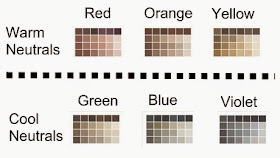"Sepia" is a term you might be familiar with for an art style that uses mostly Yellow Neutrals. However, a painting style that uses a single colour is called "Monochromatic", which I'll look at next.
Any of the other art styles I've covered can be used when painting with Neutrals. The mixes of Hues, contrasting lights and darks, softer blended ranges, etc.
The chart here is a good guide on colour intensity. To create Near-Neutrals, you really do want to go past the "Dull" colours, where the colour really starts to disappear and the grey tone becomes apparent.
 |
| Created with painter from Bolder & Chainsword |
- You'll need to mix most of these colours yourself.
- For light Tints, start with White paint and add a tiny bit of colour until it looks right.
- For dark Shades, start with your colour and add a tiny bit of black until it looks right.
- Use Greys too, or mix White in to the Shade you're making or Black in to the Tint.
- You need to mix so much paint that the original colour becomes difficult to determine, looks grey or looks earthy.
- Use the images here as an example of how far away from the Hues you need to get before your paint is considered Neutral.
- Pick up Neutral paint swatches from a hardware or paint store to use as reference while painting.
- Mixing two Complementary colours together will also create grey.
Now That's Grim-Dark
Painting the base layers of this miniature was done by mixing colours with black or light grey. The majority was green mixed with various amounts of black. His fist and gun were red with black and the eagle on his chest and fingers were done with yellow and grey. The skin on his head was simply light grey.
It's worth noticing that you can already see shadows standing out in details. That's because of two things - first, I used a white primer and second, I thinned all the paints a little with water. This makes details pop and washes go much further.
A tip for mixing the colours: Start with black, grey or white on your palette, then mix a little of the intended colour in. You only want to add a little.
The base colours pictured here aren't much to see. But this is another example of why you HAVE to use washes when you're painting tabletop quality stuff or just starting out.
This is one of the few times I used the Black wash on colours, as I wanted to deepen things - the dark greens and skin. I used a camo coloured wash on lighter greens, chestnut brown wash on the reds and a lighter brown wash on the yellows.
After seeing how everything looks once the washes dried, I decided not to highlight because, honestly, the washes tied everything together beautifully.





No comments :
Post a Comment
Please keep all comments civil and language appropriate for a child-safe environment.